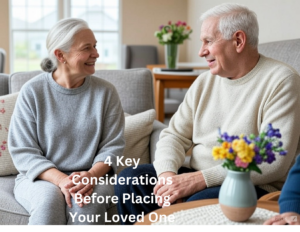Hospitalizations and Older Adults: The Scope of the Problem
- Patients 65 years and older represent nearly 40 percent of hospitalized adults, despite making up less than 15% of the population.
- The Emergency Department visit rate for those over 65 is over 500 per 1,000 persons and increases with age.
- Twenty-nine percent of ED visits by persons aged 65 and over were related to injury, and the percentage was higher among those aged 85 and over than among those aged 65–74 or 75–84. The percentage caused by falls increases dramatically with age.
- Between 1 in 3 and 1 in 5 older patients will be readmitted within 30 days of leaving the hospital.
How This Affects Older Adults and Their Families
Clearly, rushing to the ER and being hospitalized is stressful. But, worse, it leads to numerous consequences for the older adult and their family caregivers. First, older adults are vulnerable to falls, infections, and increased cognitive problems (hospital delirium and/or worsening dementia and general decline that lasts) when hospitalized. Hospitalizations often lead to a spiral of decline. Many hospitalizations end in an elder going to a nursing/rehabilitation center, but what many people don’t realize is that those temporary arrangements often lead to longer term placement.
If you’ve ever been hospitalized, you can extrapolate from how you felt and functioned afterward. For an older adult who may already have multiple conditions, mobility issues, or memory problems, those issues are multiplied.
Rehospitalizations remain a big problem due to some of these things, as well as more preventable issues. Elders and families suffer the costs of hospitalizations, both financial and emotional.
Caregivers not only feel the stress of these crises (oh, those dreaded middle-of-the-night calls!) but have to adjust to a loved one who needs more help.
How Home Care Prevents Hospitalizations and Moving to a Nursing Home Unnecessarily
Traditionally, healthcare has consisted of managing issues, often reactively: visits to the doctor’s office for a diagnosis and treatment plan, and caregivers dealing with daily needs, often with little connection. Our healthcare system does well at addressing acute needs, but the statistics show that it has not been good at addressing older adults’ health.
An elder can have the best medicine and treatment plan, but it is often the SDOH (Social Determinants of Health) that undo the best plans. For example, an elder living in a home that is not accessible and limits their mobility is at risk for falls, isolation, and more. They will likely be one of those “stats” facing an ER visit. Another example is someone’s ability to get and prepare healthy food. The same goes, of course, for medications. This is why interventions have to reach beyond the hospital or doctor’s office. And, there we find home care!
Home care addresses these issues that are more often the cause of hospitalizations and nursing home placement than a specific medical issue. With services like medication management, healthy meal prep, personal care, falls prevention, companionship, with proper care coordination, home care provides the right environment for you to stay healthy. And, today’s home care can be much more effective in doing this thanks to technology and data.
Do I need to be thinking about home care?
{{cta(’08c4c131-217a-4c38-bcd8-c01e895cee06′,’justifycenter’)}}
Evidence-Driven Home Care
With the advancement of technology, elders today have new opportunities to take control and embrace later life. We can manage medical conditions and care needs in a seamless way, with assessments to spot issues before a crisis, remote monitoring, telehealth visits, and chronic disease management. EasyLiving has developed and evaluated our technology-powered home care program with hundreds of clients. And, it works!
EasyLiving’s Hospitalization & Rehospitalization Rate for the previous 30 days is 1.41%, which is below the national average of 15.6% and our local average of 15.9%.
Care Insights: Predictions to Reduce Risk for Falls, Hospitalizations and Nursing Home Placement
Care Insights is the predictive analytics system that helps us manage and improve clients’ risk level, care, and therefore results.
What does Care Insights help us do?
- Identify at-risk clients
- Informs better, smarter, data-driven care (with company-wide data so we can adjust to our client populations’ needs and improve efficiency and a deeper, client-level look at risk so we can change care plans based on evidence)
- Ultimately prevent falls, avoidable hospitalizations and readmissions (and thus, the need for higher levels of care including nursing home care)
This allows us to start predicting when a client might be at higher risk for hospitalization or other crises (such as falls, the #1 cause of injury, death, and early care facility placement in elders) and gain the insight we need to address their risk factors to keep them at home as long as they wish.
Think about it like this, if there’s a 95% chance of rain you probably want to take an umbrella with you when you go out for the day. If the chance is 10%, you will likely leave the umbrella behind. Similarly, we now have better data so we can predict what preventative measures specific clients might need. EasyLiving can be sure clients and families have their umbrellas when they need it!
We have long seen the benefits of home care for preventing hospitalizations and keeping people at home. Today, we are able to provide the evidence and continue improving these outcomes. Most importantly, the older adults and families we serve feel the results. They get what they most need and want: peace of mind, less stress, and better quality of life–at home, where they want to be.
Learn more: set up a time to talk with one of our elder care specialists.







